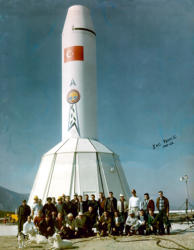HISTORY - Page 56
in production, one in development, and one in advanced design and component developments
73
. Although
DOD people were studying long-range needs for new and higher thrust rated engines, this did not solve
ABMA's problem of the moment. This meant that ABMA had to "make do" with the then present NAA
engine and suggest modifications to suit the JUPITER missile. Modifications included such items as thrust
governing and throttling.
As to the method of propulsion system operation, the main 150,000-pound-thrust engine used LOX and
kerosene. The thrust chamber was of tubular wall-type construction, with a self-impinging fuel injector
and a regenerative cooling system. Gimballing the engine, which was coupled to hydraulic actuators,
permitted missile control in pitch and yaw. There were several engine subsystems. One of these was the
propellant feed system that delivered the propellant from the tanks to the thrust unit by means of valves
and a turbopump. Also, the propulsion contained a lub oil system to lubricate the moving parts. A
pneumatic pressure system was used to operate the valves, and a hydraulic system operated the
gimballing unit
74
.
In the first stages of development, the vernier engine of the propulsion system was fueled mainly with
hydrogen peroxide—90 per cent— and a 10 per cent catalyst; but, starting with the firing of JUPITER AM-7
on 27 August 1958, a solid propellant engine was adopted. The vernier unit consisted of an engine case that
_____________________________







73. Study, Liquid Rkt Engine Dev Prog, 19 Jul 56, Hist Off files. 74. JUP Dev Plan, FY 58, 29 Sep 56.
74. JUP Dev Plan, FY 58, 29 Sep 56



Jupiter SM-78 Weapon System
I&C Team 2, Çigli AB, Turkey 1961-1962 Chrysler Corporation Missile Division

HISTORY - Page 56
in production, one in development, and one in
advanced design and component developments
73
.
Although DOD people were studying long-range needs
for new and higher thrust rated engines, this did not
solve ABMA's problem of the moment. This meant that
ABMA had to "make do" with the then present NAA
engine and suggest modifications to suit the JUPITER
missile. Modifications included such items as thrust
governing and throttling.
As to the method of propulsion system operation, the
main 150,000-pound-thrust engine used LOX and
kerosene. The thrust chamber was of tubular wall-type
construction, with a self-impinging fuel injector and a
regenerative cooling system. Gimballing the engine,
which was coupled to hydraulic actuators, permitted
missile control in pitch and yaw. There were several
engine subsystems. One of these was the propellant
feed system that delivered the propellant from the
tanks to the thrust unit by means of valves and a
turbopump. Also, the propulsion contained a lub oil
system to lubricate the moving parts. A pneumatic
pressure system was used to operate the valves, and a
hydraulic system operated the gimballing unit
74
.
In the first stages of development, the vernier engine
of the propulsion system was fueled mainly with
hydrogen peroxide—90 per cent— and a 10 per cent
catalyst; but, starting with the firing of JUPITER AM-7
on 27 August 1958, a solid propellant engine was
adopted. The vernier unit consisted of an engine case
that
_____________________________
73. Study, Liquid Rkt Engine Dev Prog, 19 Jul 56, Hist Off files. 74. JUP Dev Plan, FY 58, 29 Sep
56.
74. JUP Dev Plan, FY 58, 29 Sep 56





















